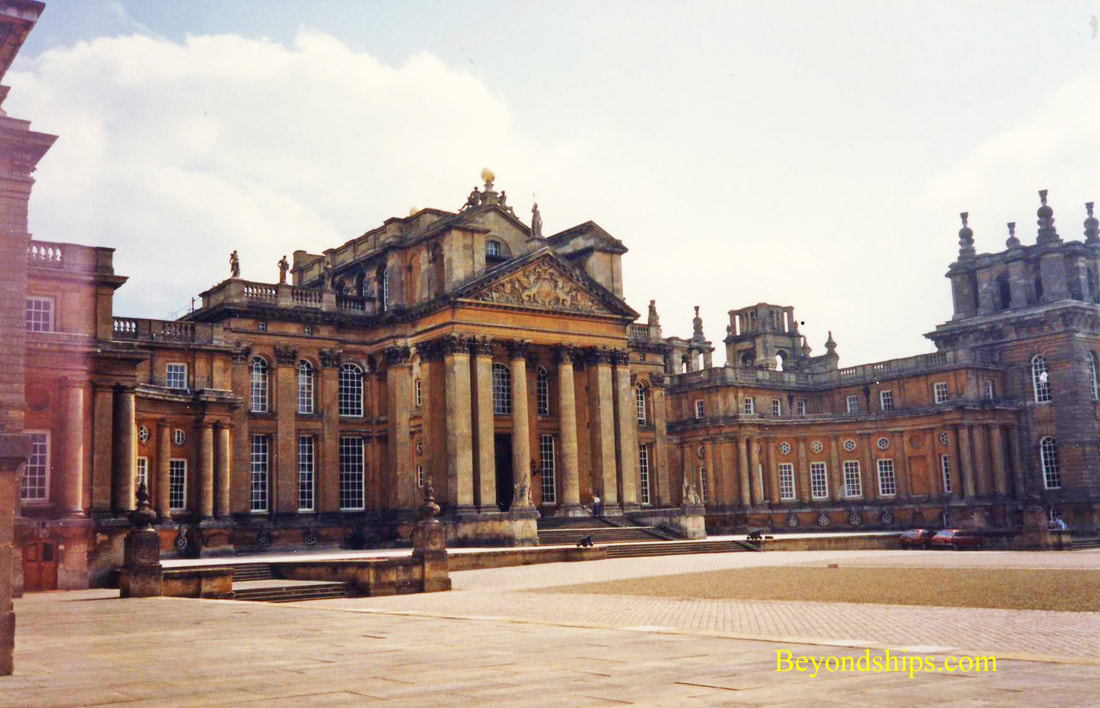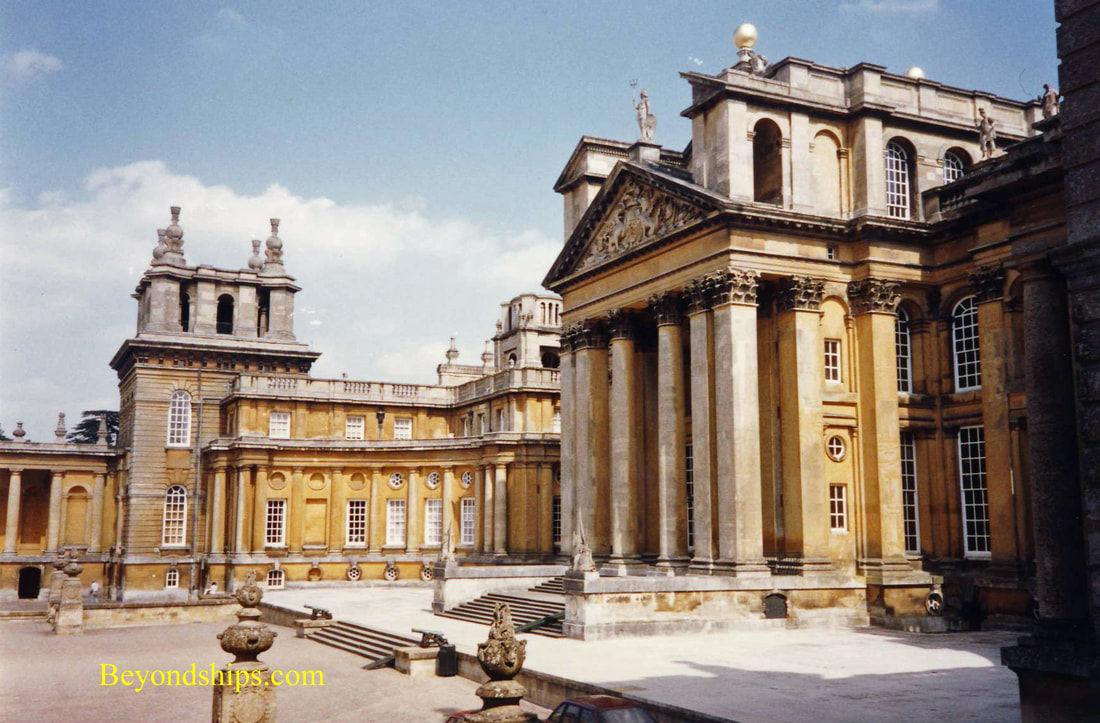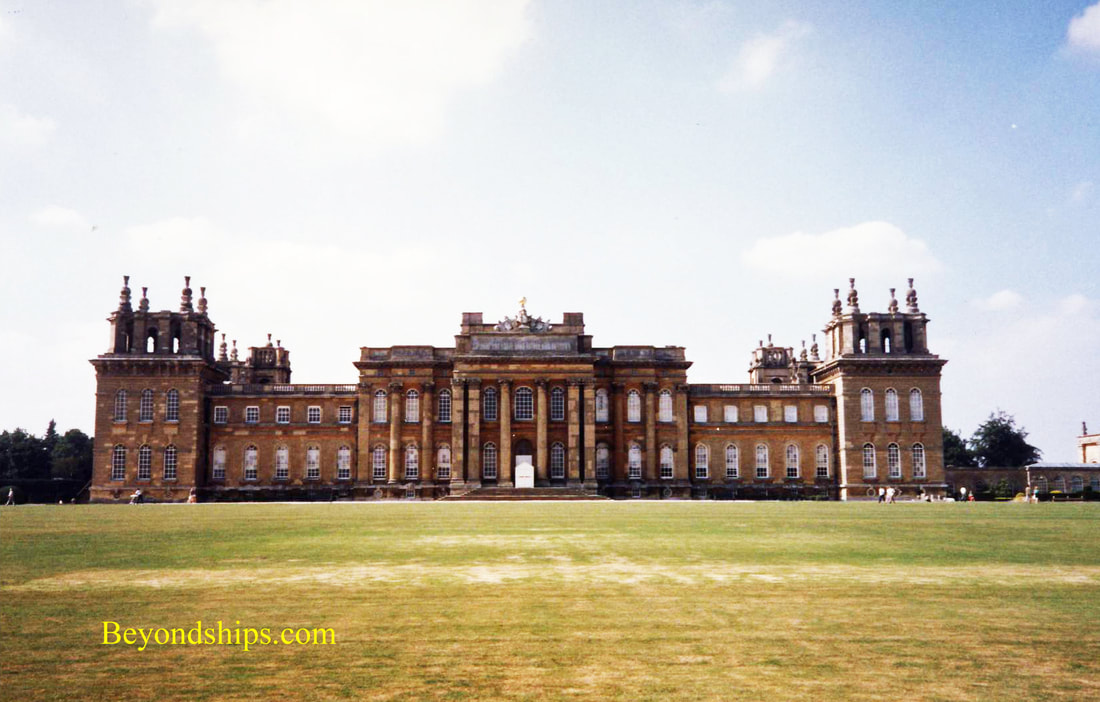|
The most impressive palace in Britain is not the home of the monarch but rather is the seat of the Duke of Marlborough. Not only does Blenheim Palace surpass any royal residence or stately home in its grandeur and opulence but Blenheim, located just north of Oxford, sits in a beautifully landscaped park. If this were not enough, it is the birthplace of Winston Churchill.
Blenheim Palace was a present. In recognition of his victory at the Battle of Blenheim in 1704, Queen Anne gave the royal estate at Woodstock to John Churchill, the 1st Duke of Marlborough. She also promised to pay to erect a palace on the estate. In exchange, all the Duke is required to do each year is to have a French battle flag to the monarch. The reason for this generosity is that the Battle of Blenheim frustrated King Louis XIV's ambition to have France dominate Europe. Marlborough used his diplomatic skills to hold together a discordant coalition of countries arrayed against Louis and his military skills to defeat the French in a series of battles in Continental Europe. While this conflict may seem obscure to modern audiences, Marlborough's victories decided the course of history. Blenheim Palace can also be said to be the product of a romance. John Churchill was the son of a minor and impoverished member of the nobility. At the court of King Charles II, John met and fell madly in love with the beautiful Sarah Jennings, the daughter of an impoverished member of the gentry. Since morals were quite relaxed at the Restoration court, Sarah, who was still a teenager, feared that John, who was by then an army colonel, was just interested in making her another of his bedroom conquests. However, he convinced her of his sincerity and they were married. John and Sarah also became a team. In addition to his military and diplomatic ventures, John was heavily involved with the politics of the day. Sarah also was skilled at politics and courtly intrigue. Much of her success was due to the fact that from the time she came to court, she was a close friend to the then-Princess Anne. Sarah continued to influence her when Anne came to the throne. While John had great diplomatic skill, Sarah had a fiery-temper and liked to have her way. As a result, she eventually alienated Queen Anne and the stream of funds for building Blenheim Palace dried up. Sarah, who was in charge of the project, turned her anger on the architect, Sir John Vanbrugh, who she continually criticized for his extravagance. Nonetheless, the family ended up paying a substantial amount to complete the palace. The project was completed in 1733, 11 years after the 1st Duke's death. The House Vanbrugh's palace is a baroque masterpiece. It is not troubled by modesty but rather is majestic and ornate. It was intended to be a monument to the glory of its sponsor, Queen Anne, and to commemorate Britain's triumph in arms over its long time enemy, France. You approach the entrance to the palace through the Great Court. It is embellished with columns and statues carved by Grindling Gibbons and his workshop. Behind the massive doors of the main entrance is the Great Hall. It soars upwards some 67 feet to ceiling painted by James Thornhill. Paintings and more carvings by Gibbons add to the room's monumental splendor. To the west of the Great Hall is a relatively small bedroom that is the birthplace of Winston Churchill. Winston was the son of Lord Randolph Churchill who was the second son of the 7th Duke of Marlborough. As a younger son, Lord Randolph did not live at Blenheim but he and his wife, the American beauty Jenny Jerome, were visiting the family homestead in November 1874 During a ball, Jenny began to have birth pains and was taken to this bedroom, which was being used as the ladies cloak room for the ball. There, she delivered Winston two months prematurely. (Sir Winston is buried with his parents at Bladon Church, the tower of which can be seen from Blenheim Palace). |
As a palace, Blenheim, of course, has a range of state rooms. These include drawing rooms, a state dining room and three rooms that are simply referred to as state rooms. All of these are ornately decorated with carvings and fin furniture. There are also a series of tapestries depicting scenes from the 1st Duke's many battles. On the walls are paintings by Reynolds, Sargent, Romney, Kneller and Van Dyck to name a few.
The Long Library is 180 feet long with stucco decoration on the ceiling high above. Vanbrugh originally intended it as a picture gallery but it has long been used as a library. The current library was assembled by the 9th Duke. There is also a large pipe organ at the far end of the room. The Chapel is the last resting place of the 1st Duke and Duchess. It includes an ornate monument to them. The Grounds Immediately adjacent to the palace are formal gardens. These include fountains and water features. While gardens were part of the original concept for the palace, the Water Terrace and the Italian Garden were designed by Achille Duchene in the first half of the 20th century. Surrounding the palace is a great park. In it, Vanbrugh erected an ornate bridge that had several levels and rooms inside it. However, this impressive bridge only crossed a rather unimpressive stream. Consequently, when the 4th Duke brought in the renowned landscape designer Capability Brown in 1764, the stream was damned and a large ornamental lake created. This flooded the lower levels of Vanbrugh's bridge but created a magnificent vista and setting for the palace. Also on the grounds is the Column of Victory, which rises 134 feet, including the statue of the 1st Duke that stands atop the monument. It stands on a rise at the end of an avenue of trees and thus acts as a focal point from the palace. Yet another feature in the grounds is the Temple of Diana. This faux ancient ruin is where Winston Churchill proposed to Clementine Hozier. For more information on visiting, see the Blenheim Palace website. |
|
|
For more about cruising to England:
Click here for our England home page Click here for our London home page |
Cruise destination - England - Oxfordshire - Blenheim Palace


